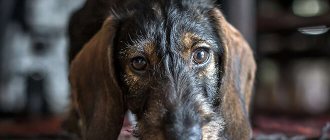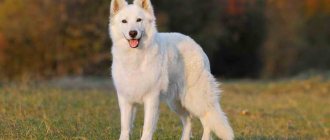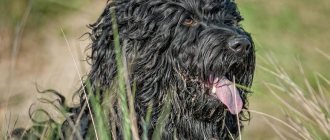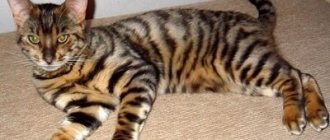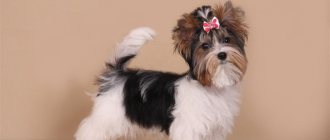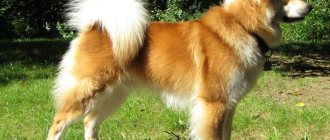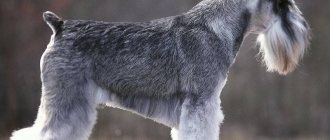History of the origin of the breed
The owners of the Foxhounds developed a new breed called the Fox Terrier. They needed a fast, small dog that could warn the owner of danger and also accompany him on the hunt. Wire-haired fox terriers went out with humans to hunt foxes. Similar to the smooth-haired, the wire-haired variety is distinguished by its determination and courage. Until recently, it was believed that these varieties were one breed, differing only in their coat.
Wirehaired Terriers
This dog's homeland is England. The predecessors of the breed were bull terriers, bigels and English terriers. People needed a fast, small dog that could warn the owner of danger and also accompany him on the hunt. The most important characteristic of a fox terrier is its size; it must be small enough to be able to enter a fox's hole.
Note! Like the smooth-haired variety, the wire-haired variety is distinguished by its determination and courage. Until recently, it was believed that these varieties were one breed, differing only in their coat.
Character
The distinctive features of Fox Terriers are energy and intelligence. They love to be close to their owner, but they are not pocket dogs. They are naturally brave, intelligent and loyal, as well as curious, playful, friendly and love people.
This love also extends to children, with whom fox terriers are friends and love to play. Only they can be rough in games and inadvertently knock small children off their feet.
Fox Terriers are good watchdogs, barking in case of danger and rushing to defense if the matter is serious.
In order for them to get along with cats and other dogs, they need to be taught to socialize from puppyhood. And it’s not a fact that it will succeed, all terriers are 100% dogs, and the fox terrier is the most energetic of them. They are cocky, do not back down in a fight, and love to hunt.
This means that small rodents are doomed if they are left alone with the dog. Attitudes towards domestic cats can be either neutral or negative.
To the neighbors unambiguous - catch! Because of this, when walking, the Wire Fox Terrier is allowed off the leash only in safe places.
This is a dominant and energetic dog that needs both physical and mental stimulation. Otherwise, they become bored and display destructive behavior.
A daily walk is a must, or better yet, running or other activity. If these requirements are met, then they live quietly in a city apartment.
Smooth Fox Terriers are average in terms of trainability and are not easy to train, but not difficult either. On the one hand, they want to please the owner, on the other, they are independent.
Obedience training can be problematic, since in addition to independence, they are also characterized by stubbornness.
Since this is a dominant breed, you need to be the leader and master in your relationship with the dog.
Training and education should not be harsh, but firm and consistent. Set rules, boundaries and limits and don't let your dog break them. If you eat, the dog should eat only after you.
If you forbid climbing onto the sofa, then she should not violate the ban. Too gentle behavior will lead to the fox terrier sitting on your head and ruining the relationship. For this reason, it is not recommended for beginners and inexperienced dog owners.
These dogs are definitely not for everyone, they are abandoned because they can run away, do not obey commands, chase people on bicycles, attack cats and other dogs. Since these are fearless hunters, this behavior is normal for them, but it is not very appropriate in the city.
The owner is required to have the ability and desire to manage the dog and give it regular exercise.
Standard and description of the Wire Fox Terrier breed
Toy Fox Terrier (American): description of the breed
The purebred Wirehaired Terrier has a spectacular and truly aristocratic appearance. The beautiful coat accentuates the attractive face and body shape. Outwardly, the dog looks not just cute, but also friendly. Real hunters know that the fox terrier behaves deftly, bravely and with endurance in his work.
The standard characteristics of the breed are quite serious; any deviations will result in the deduction of points. The commission evaluates the size of the animal, its build, and the proportionality of its body. Excessive lightness or heaviness of the dog is not allowed.
The dog's height cannot exceed 39 cm; ideal representatives of the breed weigh 8.5 kg. The official description of the Fox Terrier contains the following characteristics:
- The head is wedge-shaped, but there should be no pointing. The forehead is wide, but moderately, narrowing somewhat towards the eyes.
- Cheeks and cheekbones are flat, filled in under the eyes. The muzzle is rounded towards the end, and thanks to the fur it seems that it is cut off in this place.
- The dog's teeth are snow-white, with a correct bite.
- The eyes are oval in shape and do not have a convexity. Eye color is dark brown, the darker the better.
- The ears are semi-erect, drooping towards the ends towards the cheekbones.
- The back is short, but the whole body is rectangular in shape. The neck is muscular, of medium size, without folds.
- The forelimbs have oblique shoulder blades, the hind limbs are located further than the croup line.
- The tail may be shortened in a country where docking is not prohibited. The length of the tail is not considered at exhibitions; it can be any length.
The Wire Fox Terrier should have a dense coat and a thick undercoat. Purebred dogs are usually white in color. Black or red spots are allowed on a light background. You can often find tricolored individuals.
Cheerful young dog
Disqualifying features
This breed has fairly high standards. Among the disqualifying signs it is worth noting:
- lack of aggression towards animals, phlegmatic;
- body height is higher or lower by 2 cm from the standard;
- curly, straight, soft, erect coat;
- large spots of any color that obscure the main white shade;
- large floppy ears, similar to the ears of a hound dog.
Choosing and purchasing a fox terrier puppy
When thinking about purchasing a Wire Fox Terrier puppy, the future owner must analyze his own lifestyle and honestly answer the question of whether he wants and has enough resources to raise and maintain a hunting dog. Another important point is the class of the puppy.
Before buying, you need to firmly understand what will be required of the dog: work, victories at exhibitions, or the Fox will just be a member of the family. Having made this decision, you need to look for a puppy either of working breeding, from hunter parents, or a baby of the “show” class, in order to have prospects for exhibitions and further matings, or of the “breeding” class - purebred and meeting the standards, but not having outstanding blood.
Wire Fox Terrier puppies
Important point! You should only purchase a puppy from nurseries that register all litters of puppies. Accordingly, the dog must have a pedigree and a brand (placed when the puppy is 45 days old). Along with the puppy, the owner will receive a puppy certificate, which includes the baby’s name, information about his parents, and information about the breeder. Later, the metric changes to a permanent pedigree - a guarantee that the dog really belongs to the declared breed.
Why can’t you buy a dog without a pedigree or from a dubious seller? Firstly, only pedigree, the presence of a brand and the reputation of the kennel can guarantee that a cute curly-haired puppy will grow into a wire fox terrier. Secondly, responsible breeders monitor the health of both parents and puppies, put their souls into them, and begin working with babies from the very first days. As a result, the owner will receive a healthy dog with a strong psyche.
Only dogs with a pedigree have the right to participate in exhibitions
If we talk about show class, a Wire Fox Terrier puppy can cost up to 30 thousand rubles; breeders who are professional hunters and raise working dogs can demand the same amount. The average price for a wire-haired Fox with a pedigree is 15,000-20,000 thousand rubles.
You need to understand that regardless of the class to which the puppy belongs, the owner’s efforts to raise, train and care for the dog will not decrease. A handsome show dog also needs to be actively walked so that between victories in the ring he doesn’t start trashing the apartment, and a hard-working hunter needs to be trimmed and combed so that his fur doesn’t turn into one big tangle.
When buying a puppy, do not forget that he will live nearby for at least ten years.
Differences with the Smooth Fox
Fox Terrier: description of the dog breed
These breeds not only have external differences, the dogs have completely different temperaments. The Smooth Fox Terrier is permeated with hostility, which speaks of the instincts of a hunting dog. The Wirehaired Fox Terrier is more disposed towards people; it is characterized by flattery and special contact with bipeds. The main external distinguishing feature is, of course, the wool.
The Wire Fox Terrier has a thick, wiry coat. The hairs will be scattered throughout the house, and besides, it is quite difficult to cut the dog's hair. The smooth-haired variety does not have problems with the coat. The only drawback is shedding, but it goes away quite quickly.
Fox Terrier on the hunt
How to raise and train a Fox Terrier?
A person thinking about purchasing a Fox Terrier puppy should understand that this is a very smart breed, but it is quite difficult to train. Fox Terriers have strong intelligence, but they are too stubborn, independent and reckless to unquestioningly fulfill the owner’s demands, especially if the command is meaningless from their point of view. Thus, a fox terrier can calmly ignore the command “Come to me” if it considers that it is more interesting for it to be away from its owner.
When teaching your pet commands, a person should try to gain his trust. Under no circumstances should you hit the dog or shout at it - such an approach will only confuse the fox terrier and ingrain in his head the idea that training is an extremely unpleasant process. You need to motivate your dog to learn with affection and treats. For each correctly executed command, you need to reward the Fox with a piece of tasty food, and also praise him loudly.
You need to train your Fox Terrier patiently and affectionately.
Yes, the fox terrier is a hunter, but from puppyhood you need to introduce him to the basics of training, teach him basic commands (“Sit”, “Lie down”, “Near”, “Come to me” and the like). The best option would be to take the puppy to group training with a canine instructor, who will explain to the owner the rules for training the dog and also monitor the correctness of the process.
You should not demand incredible success in obedience and training from your Fox. The main thing is that the dog is manageable, trusts its owner and does not try to dominate, and also understands everyday commands. Also, the dog must be trained not to pull on the leash when moving, to return to the owner on command, and not to pick up from the ground. If the fox terrier will be attending hunting events, it would be best to contact a trainer who works with hunting dogs to train it. Information about such training can be obtained from the breeders who sold the puppy to the owner.
It is advisable to engage in active sports with a fox terrier, for example, agility.
Features of character and behavior
Smooth Fox Terrier: description of breed and character
The Wire Fox Terrier has a character typical of terriers. The dog is active, playful, inquisitive. This pet will become a true friend for children at any age. The animal is smart and loves to learn, despite its stubbornness.
Attitude towards strangers, protection of the owner and home
These dogs have a particularly developed hunting instinct. The animal will protect its owner to the last, no matter what kind of opponent he gets. This dog is wary of strangers and will not be able to be petted. The Longhaired Fox Terrier protects not only its owner, but also the house in which it lives. A strange dog, cat or any other animal will not enter the territory of the area guarded by a wire-haired fox, and if they manage to do this, they will definitely not be in trouble.
Training
The dog is quite smart, so there will be no problems in training him. At the beginning of work, minor difficulties may arise, but they can be overcome. The dog is very observant and has a good memory. Maximum obedience of the animal allows you not to worry about the dog ignoring complex commands.
Mating
Sexual maturity in fox terriers occurs at the age of 8-12 months. A female is bred for the first time at 20 months, a male at 24. It is best to carry out the first mating after the third heat.
A month and a half before the planned mating, it is recommended to be tested for anaerobic infections. A month before the expected estrus, the bitch is treated for skin parasites.
Mating of smooth-haired and wire-haired terriers is prohibited by the standard. Breeders advise mating to take place in the male dog's territory. The ideal time of day is the morning, before the first feeding.
Hunting with a fox terrier
From the name of the breed, it becomes clear that the dog was bred to hunt foxes. But there may not be an innate interest in going hunting and getting into narrow, dark holes, so it needs to be developed from childhood. When a dog gets his first skills on a real hunt, his interest in this matter becomes maximum.
Note! With proper upbringing, timely training on animals and other techniques, the owner receives a brave hunting dog.
Origin
The Wire Fox Terrier has an ancient and rich history. Its homeland is the British Isles. The dog was first mentioned in writing in the 12th century. Terriers are a large group of breeds, making it difficult to sort through the confusing pedigrees. The ancestors of the Fox could have been turf dogs or hounds crossed with terriers. The name of the breed comes from the Latin word terra, which means earth. It reflects the purpose of the dog - hunting burrowing animals. It is also clear from the name that terriers were used to bait foxes.
The first breeding work began in the 17th century. At the same time, the characteristic features of the breed began to form. The Fox Terrier began to take on recognizable features due to the infusion of blood from smooth-haired, white and wire-haired terriers, as well as hounds, dachshunds, spaniels and beagles. The latest breeds of dogs were allowed to be crossed in very measured doses, so as not to harm the appearance of the Fox and improve its working qualities.
In the 18th century, fox hunting gained enormous popularity, which could not but affect the demand for terriers: the dogs' task was to drive the animal out of the hole. Most often, they worked in tandem with foxhounds, which drove prey, but could not fit into narrow crevices. The smooth-haired variety of the terrier was more preferable: the short coat did not accumulate soil and dirt, and was therefore easy to clean. An important condition was the predominance of white in color - this helped hunters not to lose sight of the dog.
Hunters transported foxes in special travel bags or shoulder bags. This compensated for the lack of speed and endurance.
Performance optimization continued into the 19th century. During selection, fox terriers became much more compact: their shoulders and skulls narrowed, and the gap between the shoulder blades decreased. Foxes were first shown at an exhibition in 1859, and already in 1886 the first special breed exhibition took place. The standard was formalized in 1876.
In the eighties, terriers became popular outside of England. They were exported to Russia, Austria and Germany. One of the largest breeders was Francis Redmont. Puppies from his kennel have been distributed all over the world.
How to Groom a Wire-Coated Fox Terrier
These dogs cannot be cut, otherwise the coat will become thin and extremely soft, and the color will fade. In this case, it is customary to use trimming, which is essentially plucking the fur. Trim the dog no more than 3 times a year.
Eye hygiene
This breed often suffers from eye diseases in the form of cataracts and inflammatory processes. To prevent the development of pathology, it is necessary to carry out regular eye hygiene. It is important to conduct examinations with a veterinarian, who can prescribe special preventive drops, or undertake timely treatment of an incipient disease.
Walk
This breed requires constant active walking. The dog needs to be walked several times a day for 2 hours. If you do not provide her with physical activity, furniture and other items in the house will certainly suffer. It is better to walk outside the city, since within its boundaries the dog should not be let off the leash.
Training
Training begins from the first months of life. First, the puppy is taught to respond to its name and introduced to its family. Early socialization is very important for terriers. The most difficult thing is to teach a dog to suppress the hunter's instincts.
It is recommended to carry out training in a playful way. At least until the dog develops a habit of exercise. If the Fox gets involved in this process, he will willingly carry out the command in order to earn the approval of the owner. If the dog does not make contact, you should contact a dog handler.
What to feed a dog of this breed
The dog owner has the right to choose whether to feed him dry food or natural food. If the choice fell on natural ingredients, then the diet should consist of:
- meat, at least 50% (you should choose only low-fat varieties);
- boiled offal;
- buckwheat, rice, oatmeal;
- vegetables;
- fermented milk products several times a week;
- eggs.
Note! It is strictly forbidden to give spicy, salty and sweet foods. Dry food should be balanced; premium formulations are suitable.
Description and characteristics of the terrier
Positive character traits of the Smooth Fox Terrier:
- Devotion;
- Energy;
- Tirelessness;
- Playfulness;
- High level of intelligence;
- Sociability.
Negative traits:
- Hot temper;
- Tirelessness;
- Fights with other dogs are possible;
- Barks frequently;
- Exorbitant appetite.
Most of the listed traits are inherent in almost all dogs from the terrier group. Their work requires qualities such as excitability and healthy malice.
The description of the Wire Fox Terrier makes it clear that this breed has the following qualities:
- stubbornness;
- increased mobility;
- boundless devotion and love for the owner;
- speed reaction;
- hostile attitude towards opponents;
- excessive productivity;
- desire to dominate.
Fox Terrier Wirehair
The smooth-haired and wire-haired fox terriers have a rather hot-tempered character, so they cannot be called an angel. Not many owners can tolerate increased love from a pet. The owner’s patience will be tested from various angles, but if contact is still established, a more devoted friend will not be found.
History of the breed
The Wire Fox Terrier first appeared in England, bred by lovers of hunting foxes and other small animals living in burrows. It is generally accepted that the animal's ancestors are the tan terriers of Durham, Wales and Derbyshire. Hounds picked up prey, but fox terriers had a different task - to pursue the animal, drive it out of its holes or strangle it. There is an opinion that the short tail is a convenient handle; you can use it to pull your pet out of the hole if it gets stuck.
At first, smooth-haired and wire-haired breeds did not differ from each other and they were even crossed, but soon their minor differences were noticed and classified as different breeds. Modern genetic analysis proves these distinctive features, which is why dogs belong to different types, despite their similarities.
For a long time, only representatives of the nobility and aristocracy were engaged in hunting, so the breed did not gain much popularity. Although Queen Victoria's son, Edward VII, had a wire-haired fox terrier. This situation changed in 1930, because that year millions of people saw the amazing film “The Thin Man”, where one of the roles was played by a fox terrier.
The popularity of the breed lasted until the end of the century, after which it dropped significantly due to changes in people’s living conditions, when they began to leave villages en masse and move to cities. It is very difficult to restrain the hunting instinct of a fox terrier in such conditions. Today this breed is not the leader in popularity, but it is not one of the rarest. Finding this breed is not difficult now, so you can safely regard the fox terrier as a potential pet.
How to choose a Wire Fox Terrier puppy
For hunting, a puppy must be selected taking into account its parental characteristics. In specialized nurseries you can choose a suitable baby. These dogs will cost much more than regular working dogs. When choosing a puppy, you should pay attention to its appearance and behavior. It is important to examine the ears and eyes; there should be no discharge. An active and curious baby is healthy, but a lethargic one with obvious signs of illness cannot be allowed for sale.
Fox Terrier Wirehaired
- home
- Articles
- Encyclopedia of Animal Species
- Dogs
- Fox Terrier Wirehaired
- Content
- Description
- Character
- Maintenance and care
- History of the breed
- Interesting Facts
- FCI standard
The Fox Terrier is an alert, very temperamental, full of hunting passion, wary dog with fast movements and lightning-fast reactions, always ready with selfless courage to rush into battle with any opponent superior to its strength. Once upon a time, these terriers were called \\\"little athletes in the dog world\\\" and they, of course, must lead a corresponding lifestyle. Wire-haired foxes require hand plucking in the spring, summer and fall, and more often if the dog is being prepared for shows.
Description The Fox Terrier is an alert, very temperamental, full of hunting passion, wary dog with fast movements and lightning-fast reactions, always ready with selfless courage to rush into battle with any opponent superior to its strength. In addition, the Fox is a very elegant, beautiful, well-proportioned dog, which is characterized by an energetic and tense stance with its head held high. With their help, small fur-bearing animals are caught. Foxes are used in catching game birds, which these dogs drive out of the thickets and serve after successful shots, both from the grass and from the water. While searching, fox terriers, as a rule, stay close to the leader, chasing raised birds and animals briefly. This makes foxes desirable assistants to beaters on round-up hunts. And at the end of the raid, a dog trained to work on a blood trail helps to find the shot trophies, including wounded animals.
Character Fox is a smart, cheerful, brave, dexterous, fast, active dog. Easy to train. Distrustful of strangers. This is a reliable friend and protector of its owner.
Maintenance and care These terriers were once called “the little athletes of the dog world” and they, of course, must lead an appropriate lifestyle. They can be walked on a leash in the park, but they should be allowed to run freely more often, and best of all, outside the city. Wire-haired foxes require hand plucking in the spring, summer and fall, and more often if the dog is being prepared for shows. Daily brushing is sufficient, but you should always monitor the condition of the animal's skin, as these dogs often develop eczema. A well, correctly and carefully trimmed Fox Terrier is extremely beautiful and elegant. If you want to become the owner of a winning dog, then you should never neglect trimming. Wire Fox Terriers cannot be clipped. When sheared, the fur becomes thin and soft, and the color fades. After two or three haircuts, there will be nothing left of the luxurious, bright dog, just a dull, matted lump of cotton wool. In addition to being purely aesthetic, the fox terrier’s hard and bright coat also has practical significance - it does not get dirty and does not allow water to reach the skin. A bright dog is clearly visible in a forest or field. In addition, cut dogs are more likely to have skin diseases such as eczema and dermatitis. Typically, Wire Fox Terriers are trimmed three times a year, but there are dogs with very fast-growing hair that need to be trimmed four times a year. You can pluck a 4-5 month old puppy for the first time. At this age, the puppy's coat changes to that of an adult. But accustoming to the trimming procedure should begin at 1.5-2 months of age. Fine combs with round metal teeth of medium length are suitable for combing wire-haired fox terriers. Trimming fox terriers is done with a special tool called a trimming comb or simply trimming. To care for the coat of adult fox terriers, you need to have two types of trimming - medium and small. Medium trimming is used to treat the back, sides, neck, back of the head and hind legs of the dog, and small trimming is used to pinch the cheeks, ears, inner surface of the hind legs, and sometimes the chest. A four-month-old fox terrier puppy is first simply brushed with a trimmer instead of a comb. And then, when the hair begins to pinch, you can start trimming. For better growth of adult hair, you should strive to completely pluck the puppy's hair, without resorting to the help of scissors. Just the hair on the paws and face should not be plucked, but they should be brushed well every day. For wire-haired fox terriers, during normal sanitary trimming, the back, sides, neck, chest, cheeks and ears are plucked as much as possible, while the ears are trimmed on both sides. Not all dogs allow the belly, hind legs and ischial tuberosities to be pinched, so they must be trimmed very carefully, trying not to cause pain to the dog, in several steps. The fur between the toes in the paw pads is cut or plucked, this is especially important in winter, so that less snow sticks and ice does not form between the toes. The decorative fur on the paws and face is trimmed by plucking individual protruding tufts of hair with your fingers. The front legs should look like an extension of the shoulders and look like two columns. On the hind legs, the hair is left from the knee along the entire paw in front and on the back of the metatarsus. The mustache, beard and eyebrows are trimmed to give the muzzle the characteristic squareness of a terrier; their length is adjusted based on the general impression of the dog and its exterior. About a week after trimming, Wire Fox Terriers begin to grow an undercoat. It needs to be combed out very carefully with a fine-toothed, short-toothed comb, so that the undercoat does not interfere with the growth of coarse guard hair. Brush the undercoat very carefully every day so as not to injure the dog's skin with the comb. The difficulty with show trimming of Wire Fox Terriers is that the coat must be of different lengths on different parts of the body, but must not show signs of clipping. One week before the show, the dog is examined, carefully trimmed and everything that makes you want to be completed is completed. The hair on the belly is trimmed and the hair on the paws and face is trimmed. The dog is washed for the last time before the exhibition no later than a week, using special shampoos and the dog’s hair is dried and styled in a special way, otherwise it will be disheveled. The paws and belly are naturally washed as they become dirty. In bad weather, even when walking in overalls, you have to wash your paws after every walk. Immediately before the ring, the fox terrier's coat is combed well and sprayed with hairspray. It is better to use special varnishes for dogs. It should be especially noted that exhibition trimming of fox terriers is done taking into account the dog’s constitution and its physical shape.
History of the Breed Fox Terriers have been known as a breed since the late 17th or early 18th centuries. They were bred in England specifically for fox hunting, as evidenced by the name of the breed (fox-fox, terra-earth). The breed arose from a cross between the Old English Wirehaired Black and Tan Terrier, the Smooth Black and Ten Terrier and the now extinct Old English White Terrier. During the formation of the breed, to give these terriers more viciousness, flair and beautiful markings, they may have been infused with the blood of bullterers, beagles and spaniels. When these crosses were crossed with brown and red terriers, rather light-colored dogs were obtained, noticeably different in color from the fox. However, these crossings were carried out so carefully that the terrier type almost did not change at all. The narrow passage of the fox hole determined the further choice of shape and size of the dog. As a result of long-term selection work, a small terrier was obtained, the color of which was predominantly white with red and black spots. Already in the middle of the 19th century, fox terriers had a very high exterior level, and later became the most popular terrier breed in England. Two varieties of fox terriers have long been known: smooth-haired and wire-haired. Initially, only smooth-haired foxes existed. The origin of the Wire Fox Terrier is hidden in the darkness of centuries. Its most ancient ancestors are most likely to be found among the rough-coated black and tan Welsh Terriers, which were crossed with the smooth fox terriers to add white color, a clean line of the head and the "hunter" pattern of the gunter. At first, smooth-haired and wire-haired fox terriers were exhibited together at exhibitions, they were not separated by coat, and smooth-haired foxes dominated, significantly outnumbering them, and wire-haired ones did not attract much attention. For the first time, separate classes for wire-haired dogs were established in 1872 at the Birmingham Exhibition, since then each variety has been exhibited separately. A separate standard for Wire Fox Terriers was adopted in 1913, the year the Wire Fox Terrier Association was founded. This standard has been revised several times, but has received minor clarifications. The Wire Fox Terrier is judged at modern shows according to FCI standard No. 169, 1997.
Interesting Facts 1. Many years ago, English literature often referred to small dogs called “terriers,” a French word derived from the Latin “terrarius,” meaning “earthy.” 2. Mr. T. H. Scott - writer: “A dog belonging to my father followed its prey into a hole and did not appear on the surface for several hours. Worried, I dug into the ground with a shovel and found the dog still in a heated fight with the huge raccoons. The little dog was “terribly torn, but showed no sign of retreating.” 3. October 4 - World Animal Day 4. Before the exhibition, the hair of the Wire Fox Terrier is treated with chalk.
FCI standard Origin: UK. Date of publication of the previously valid standard: 12/01/1997. Application: Terrier. FCI classification: Group 3. Terriers. Section 1. Large and medium-sized terriers. Performance tests are optional. General Appearance: The Wire Fox Terrier is active, lively, bony and strong to a small extent, and in no way shapeless or coarse. Perfect, balanced addition; in particular, this concerns the ratio of the cranial part and the forceps, as well as the height at the withers and the oblique length of the body from the protrusion of the shoulder-scapular joint to the ischial tuberosity, which look approximately equal. The stance resembles a hunting horse with a short top, covering a lot of space. Behavior and temperament: Alert, moves quickly, with a penetrating gaze, tense in anticipation of the slightest irritant. Friendly, outgoing and fearless. Head: Skull: The upper line of the skull is almost flat, with a slight decline, the width of the skull gradually decreases towards the eyes. Transition from forehead to muzzle: Weak. Facial part: Nose: Black. Muzzle: Little difference in length between skull and muzzle. If the muzzle is significantly shorter, the head appears weak and unfinished. The pincer gradually tapers away from the eyes, drooping slightly from where it joins the forehead, rather than being upturned and sunken under the eyes where it should be well filled. Full and rounded cheekbones are undesirable. Jaws and Teeth: The jaws are strong, with a perfect, regular and complete scissor bite, i.e. The upper teeth closely overlap the lower teeth and stand perpendicular to the jaws. Excessive development of jaw muscles and bones is neither desirable nor attractive. Eyes: Dark, full of inspiration and intelligence, moderately small, not protruding. Almost as round as possible. Set neither too far apart, nor too high on the skull, nor too close to the ears. Light eyes are extremely undesirable. Ears: Small, pendulous, triangular, of moderate thickness, with a distinct fold, the tips drooping forward close to the cheekbones. The upper line of the ear fold rises significantly above the level of the skull. Pricked, semi-pricked and raised ears are extremely undesirable. Neck: Dry, muscular, fairly long, without a chin, widening towards the shoulders, forming a graceful curve when viewed from the side. Block (body): Back (from withers to forelocks): Short, level and strong, without weakness. Loin: Muscular, slightly arched. Very short. Chest: The sternum is deep; true ribs moderately arched; false ribs deep, convex. Tail: Usually docked. Set on high, carried elevated, not over the back or curled. Strong, quite long. Limbs: Forequarters: Viewed from the front, the shoulders slope steeply from the junction with the neck to the delicate projections of the glenohumeral joints; When viewed from the side, the shoulders are long and very slanting. The withers are always clearly defined. The chest is deep and not wide. When viewed from any side, the limbs are straight, the bones are strong right down to the paws. The elbows are directed strictly back, working without interference on the sides, and are carried straight out when moving. Hindquarters: Strong, muscular, without sloping or sabering. The combination of a short shin and a straight knee is extremely undesirable. Hips: Long and powerful. Stifles: Well arched, turning neither in nor out. Hocks: Short, steep and parallel when viewed from behind. Feet: Round, balled, with small, dense and elastic pads, toes moderately arched. Turned neither in nor out. Movement: Forelegs and hindlimbs move straight forward and parallel. The elbows move strictly back, working without interference on the sides. The knees are turned neither in nor out. Good propulsion comes from well flexed and extended hindquarters. Shirt (coat texture and color): Coat: Thick, wiry, from 2 cm (3/4 inch) at the shoulders to 4 cm (1 1/2 inch) at the withers, back, ribs and legs. The undercoat is made of short, softer wool. The fur on the back and legs is coarser than on the sides. On the jaws the hair is coarse and of sufficient length to give the appearance of a strong forceps. The fur on the legs is thick and coarse. Color: Black, black and tan (saddleback) or reddish-brown spots on a predominant white background. Brindle, red, brown or bluish-gray-blue spots are undesirable. Height and Weight: The height at the withers of the Wire Fox Terrier does not exceed 39 cm (15 1/2 inches) for males; females are slightly less. Ideal weight in show condition is 8.25 kg (18 lbs) for males, females are slightly lighter. Defects: Any deviation from the above points should be regarded as a defect or defect depending on the severity. Note: Males must have two apparently normal testes fully descended into the scrotum.
Health to you and your pets!
© 2021 Team “ZOOVET” We are always happy to help you! 24-hour consultation: +7 Make an appointment [email protected]
Return to list
Who is the dog suitable for?
History of the breed
Smooth Fox Terriers are suitable for active people with a decisive character. These dogs love to work, so it is advisable to direct their energy in the right direction. For hunters of foxes and other burrowing animals, they will become the best assistants.
There is never a dull moment with Foxes, so they are taught the basics of dog sports during their teenage years. Exercise in the form of long hikes over rough terrain will strengthen the muscles and allow you to throw out excess energy.
Smooth Foxes are rare in families with small children due to their temper. The same applies to cats, ferrets and birds. Even on walks, fox terriers are not averse to chasing an animal passing by. Therefore, it is necessary to teach these wayward hunters how to communicate politely with other pets from the first months of life.
The guard qualities of smooth fox terriers are weak, but they are capable of barking at a stranger. Hunters live with them all year round, both in enclosures and in the house. In the city, these dogs are kept in apartments without problems.
The Fox Terrier is a compact dog, so it is perfect for apartment living. The dog needs a walk, otherwise his stay at home will turn into a disaster: he will run non-stop, bark and scratch the floor covering, trying to dig a hole.
When walking your dog, you need to provide it with interesting activities: make it run, jump over obstacles and follow various commands. Active pastime will allow your pet to splash out his energy - at home he will behave quite calmly. Smooth-haired dogs need to be warmed in winter by dressing in woolen sweaters or overalls. Wire-haired representatives of the breed do not require clothing.
Appearance of the animal
The Wire Fox Terrier looks proud and aristocratic in appearance, but at the same time it has a very friendly and even slightly childish expression on its face. He is distinguished by his durability, endurance and constant readiness to work. It is in his blood to serve his master.
Foxes give the impression of being strong and active dogs. Their physique is strong and proportional. Despite its small size, the animal occupies a large height when standing and has a short but fairly strong back. His stance resembles that of an athlete who is at the start and can make a jerk at any moment. The Fox Terrier, due to its special structure, is very agile, moves quickly, is dexterous and reacts almost instantly to any external stimuli.
The visual differences between dogs of different sexes are minor, but they are still visible. Males have a more massive head, and the expression of the muzzle is somewhat more aggressive.
The dog is distinguished by good health and endurance, as evidenced by its physique. These animals are bony, have well-developed muscles and a regular physique. The height at the withers reaches 34-40 cm, which is almost equal to the length of the body.
The elongated head with a flat forehead gradually tapers towards the tip of the nose. The length of the muzzle and skull are approximately equal. The transition from the muzzle to the forehead is not very pronounced and is almost imperceptible. Their cheekbones and cheeks are flat, with the exception of the area under the eyes. The end of the muzzle is round, but due to the presence of fur it looks somewhat square. The animal's jaws are very powerful, positioned strictly vertically with a correct bite.
Neat triangular ears hang on cartilages, and their ends are directed slightly forward. They are located next to each other. The nose is black, regardless of the color of the dog. The eyes have a rather interesting shape, which is somewhere between an oval and a circle. They are set slightly obliquely and not very wide, just like the eyelids; the eyes are black.
The Wire Fox Terrier has a fairly massive body, characterized by a narrow and powerful chest, a short and hardy back. The withers are clearly pronounced and protrude 1.5 cm above the animal’s back. The neck is quite long and sinewy, but this in no way violates the basic correct proportions of the animal.
Popular small dog breeds
We recommend reading: Experience with the use of Catosal and Chionate in complex therapy of complicated closed mechanical injuries in a sports horse
Previously, the tail and ears of fox terriers were docked, but due to bans on this procedure, the appearance has changed somewhat. The massive, stable forelimbs are perfectly level and remain so even when the animal moves. The hindquarters are strong and powerful, the thighs are well muscled, and the shins are of medium length.
The fur is quite thick and tough, resembling wire. Each hair has a small break, which allows the hair to adhere more tightly to the skin, creating a strong protective layer.
The dog is mostly white with black and red spots, but completely white foxes are also found.
Education and training
Fox Terriers are characterized by stubbornness and quick response to events. Therefore, the owner needs to have excellent reaction time and keep an eye on his pet outside the house.
For overall development, Fox Terriers benefit from training to develop obedience and become a civilized dog. Socialization begins immediately after quarantine. A dog living in an urban environment must have an adequate attitude towards people, transport and restrain excitement at the sight of its relatives.
Fox Terriers do not need protective or guard duty. For hunting dogs there are special bases with enclosures and wild animals. On their territory, under the supervision of an experienced instructor, burrowing dogs are trained. There is an opportunity to receive a diploma and the honorary title of a representative of the working class in your breed.
Working tests are not required for Smooth Foxes.
Not every fox terrier is born with innate working qualities. The passion for hunting must be in the blood, and subsequent activities only develop skills and add precious experience. Puppies learn faster by watching adult dogs.
Smooth fox terriers are frequent guests at competitions in various sports. These include agility and obedience. They also love simple games with balls and rubber ducks in the presence of the owner.
According to Canadian scientist Stanley Coran, the fox terrier has average learning abilities. It will take up to 40 repetitions to memorize new commands, and execution on the first return can be expected half the time or a little more often. The excitability and curiosity of smooth fox terriers are to blame for such results. However, for non-service breed dogs the indicators are satisfactory.
The Fox Terrier has an independent character and a stable psyche. His description can be summed up in two words - an English gentleman. The dog is fearless, friendly and has aristocratic manners.
The Fox Terrier breed is energetic and active. Dogs have an excitable nervous system, developed intelligence and ingenuity. Animals are very curious: they must participate in any event, explore every crevice and new box in the house.
The Fox Terrier is devoted to the family in which it lives. He chooses one owner for life. The independence and some stubbornness in the dog’s character sometimes do not allow him to completely obey the will of the owner. Dogs do not tolerate what they do not like, and can even growl at the owner if he does something inappropriate, according to Fox. Otherwise, the dogs are very sociable and friendly.
The dog gets along with all family members, is a companion and protector. When strangers approach, he barks. He is not particularly gentle when playing with children, so it is better not to leave him with children. The dog does not have good relationships with other pets. During a walk, a fox terrier can rush into battle with a stronger opponent, so it is better to keep it on a leash.
Dogs of the Fox Terrier breed need a strict hierarchy - the owner needs to become a leader for the pet. The owner must have endurance and patience in order to raise an obedient animal. First of all, he is toilet trained. Starting from 3 months, you need to practice basic commands with the puppy: “come to me”, “fu”, etc. The duration of classes at first should not exceed 15 minutes, the dog must be trained before feeding.
Rules for keeping and caring for the Wire Fox Terrier
- Eyes. This part of the body needs to be examined daily. Accumulated fluid and hair in the eye area are removed with special wipes or a clean gauze swab. Cotton wool is not suitable for such manipulations. If you notice purulent discharge, then you should definitely visit a veterinary clinic.
- Ears. This breed is characterized by the problem of hearing loss and the occurrence of all kinds of inflammatory phenomena in the auricle. That is why you need to clean your animal’s ears using a special product once every 2 weeks, although it is better to increase the frequency of this action. It is better to pluck the hairs that are in the ear canal; this procedure is an excellent prevention of various diseases.
- Teeth. The peculiarities of modern life do not allow the teeth to experience the necessary load, so a characteristic plaque is present on their surface. You need to get rid of it periodically to prevent serious problems. In advanced cases, you need to use a toothbrush for cleaning in combination with a special preparation from the pet store.
- Claws. Parts that need to be inspected regularly include the paw pads. The dog needs to systematically walk on a hard surface, otherwise the nails will wear down poorly. In this case, you need to use a nail clipper. The procedure is carried out carefully, cutting off a few millimeters at a time so as not to affect the living area of the nail where the nerves and blood vessels are located.
- Wool. The smooth-haired breed needs to wipe its paws after a walk and wash its face after eating. The coat is brushed weekly with a stiff brush; long-haired fox terriers require more frequent grooming. During active molting, the hairs are removed with a special mitten.
It should be noted that Fox fur has a unique structure, due to which dirt does not stick to it. Terriers cannot often be bathed; a bath is best for this. The dog is placed in non-hot water, its level should be below the stomach. After this, the body is watered with water, shampoo is applied and carefully washed off.
We invite you to read: Chihuahuas are sometimes small in stature - this is a big advantage
Many people want to get a wire-haired fox terrier; the characteristics of the breed allow us to say that this is a very interesting and unusual animal. In modern realities, few people engage in hunting, but even in urban conditions, the Fox will become an excellent pet and will give a lot of new emotions. The main thing is to educate him and take into account several important aspects when caring for him, paying special attention to the ears, eyes, fur, teeth and bathing.
